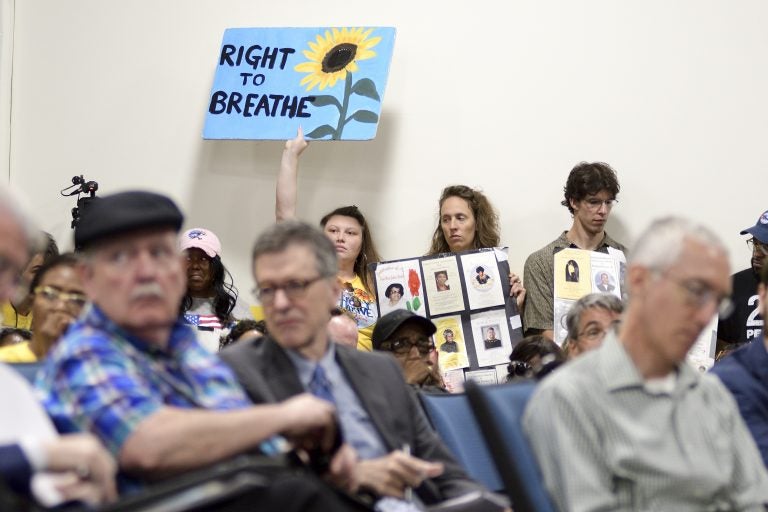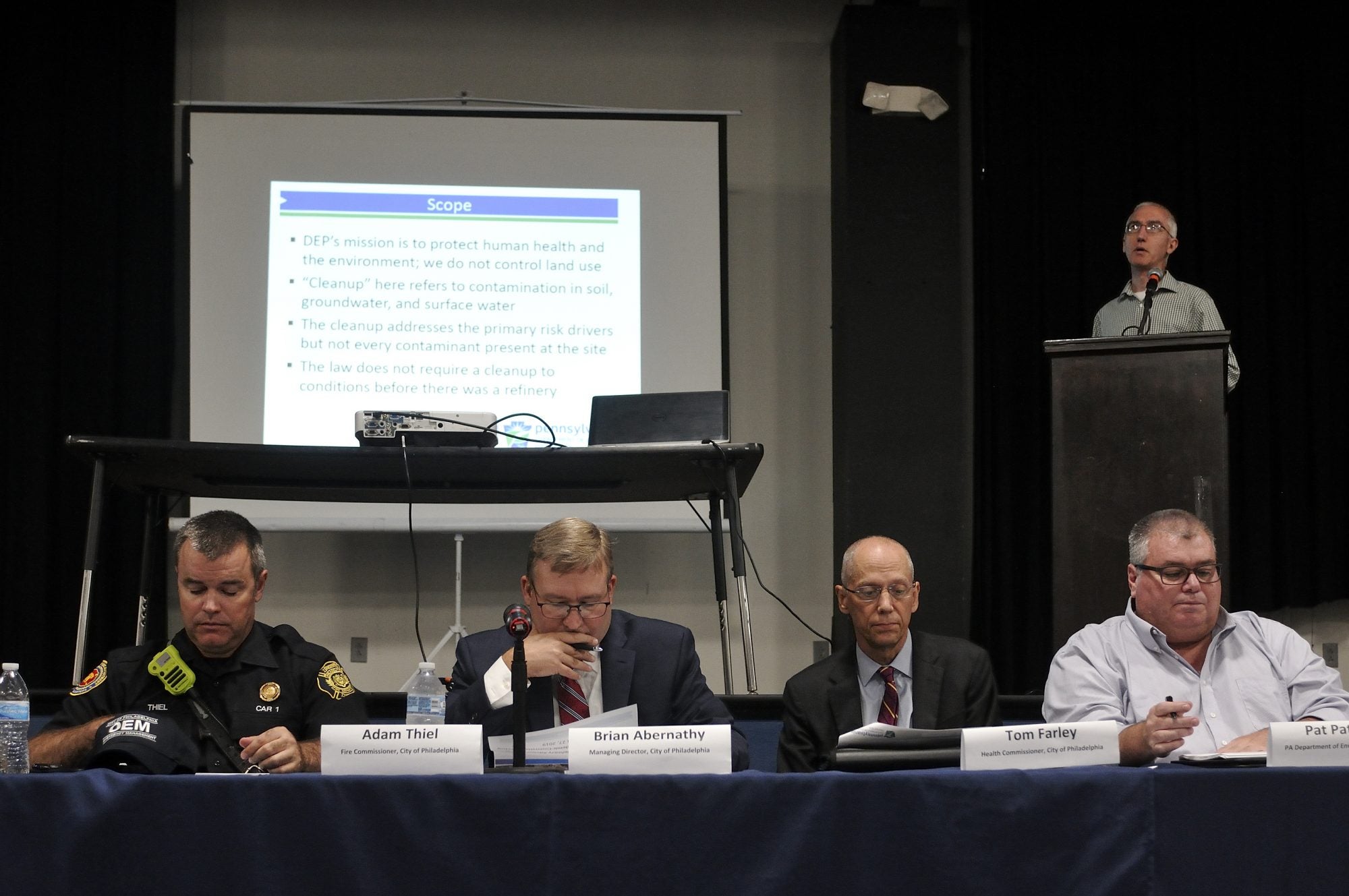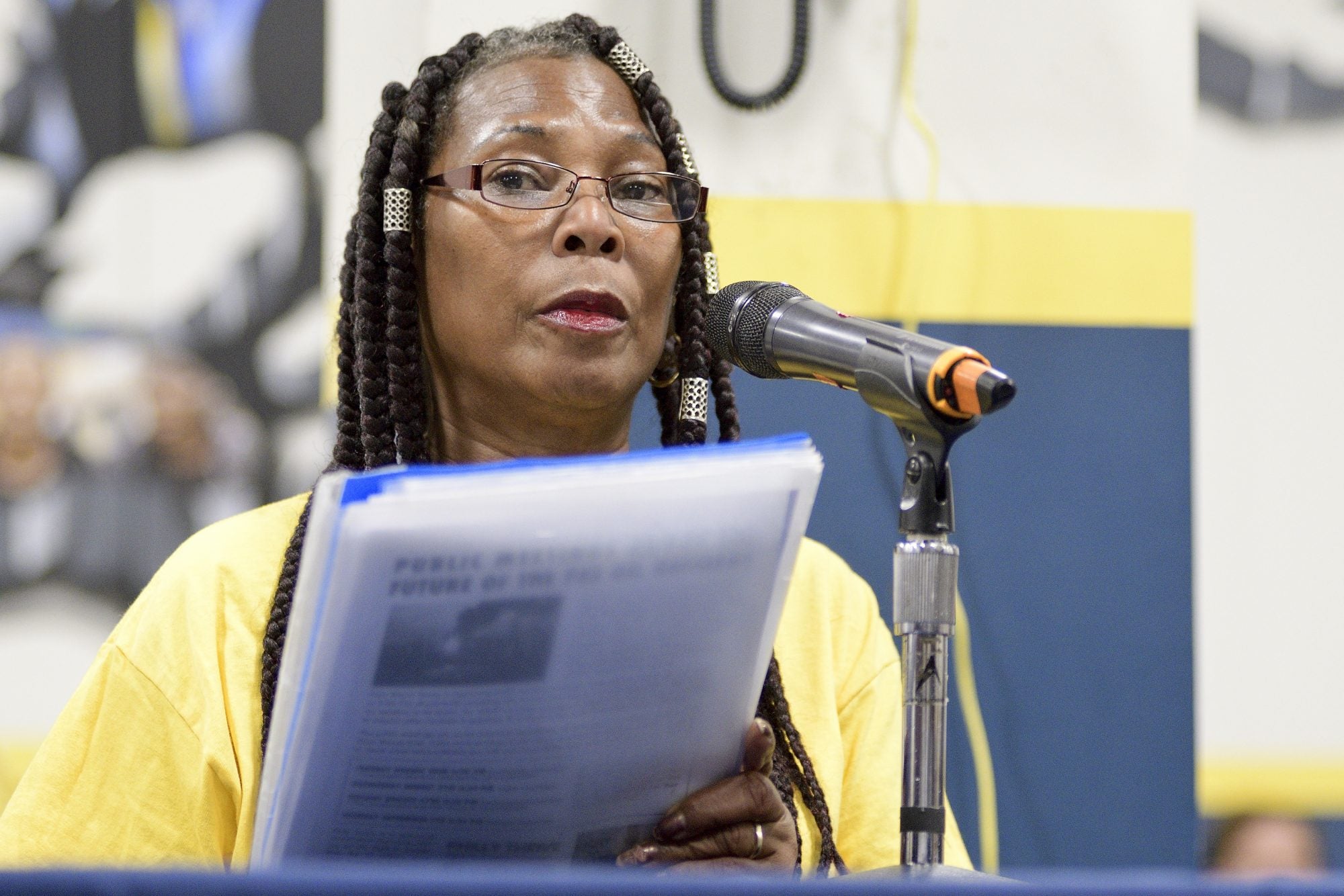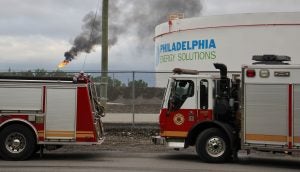New uses, even non-use, will complicate ongoing PES refinery cleanup, DEP says
Pennsylvania’s DEP offered an update on, and a possible wrinkle in, the ongoing Sunoco-era remediation at the Philadelphia Energy Solutions complex.

Signs are held up as a standing room only crowd listens to testimony given by environmental experts, community activists and residents during a community meeting regarding the future of the site of Philadelphia Energy Solutions in August 2019. (Bastiaan Slabbers for WHYY)
Updated 10:50 a.m. Aug. 30
Pennsylvania’s Department of Environmental Protection offered an update on — and a possible complication in — the ongoing Sunoco-era cleanup at the Philadelphia Energy Solutions complex during the latest meeting of the city’s Refinery Advisory Group.
Toxic pollutants have poured onto the 1,300 acres in South Philadelphia — home to what are now the PES refineries — for over 150 years. The list of contaminants of concern found in the soil, groundwater and surface water include hard-to-pronounce compounds such as methyl tert-butyl ether. The late June fire and explosion at PES that spurred the creation of the Refinery Advisory Group underlined the environmental dangers of having heavy industry in the middle of a city.
Cleanups were underway long before the fire and its ripple effects got the city looking in that direction. Sunoco (now Energy Transfer), the previous owner of the site, is responsible for addressing the historic contamination there. The company has been remediating the site since 1993 under various agreements overseen by the DEP and the Environmental Protection Agency. Post-2012 contamination resulting from operations of the complex falls to PES to address, under a buyer-seller agreement between the two companies.
But with the possibility of either the permanent shutdown of the complex — PES ceased operations because of damage caused by the fire, then filed for Chapter 11 bankruptcy and laid off much of its workforce — or its sale for new uses to be determined by future buyers, all of that work might have to change, a DEP official said at Tuesday’s Refinery Advisory Group session, which focused on environmental issues.
“All the work that has been going on in the last 30 years has been under conditions of an operating refinery,” said David Brown, of the agency’s Bureau of Environmental Cleanup & Brownfields. “That has meant that there have been some areas that have not been investigated.”
In 2003, Sunoco identified the contaminants and made cleanup plans for the entire facility, divided into 10 geographic areas of interest. But operating units of the refinery were not included because it was not safe to drill or make holes to take samples.
“So an implication of a permanent shutdown of the refinery is that Evergreen would need to come back and, as areas are dismantled to investigation, they would have to … do further work,” Brown said, referring to Evergreen Resources Group, which is managing the cleanup for Sunoco.
If any of the potential buyers of the refinery — and there are already two, PES former CEO Phil Rinaldi’s newly formed Philadelphia Energy Industries and Philly-based biofuels company S.G. Preston — removes existing equipment before Sunoco finishes remediating the site, Sunoco would have to pay for cleaning that soil or groundwater contamination to prevent anyone on the site from being exposed.
Evergreen’s deadline for completing its remediation report is December 2020, but Brown said that will probably need to be extended. There is still plenty of work to be done and many uncertainties. Evergreen must complete site characterization for two areas where cleanup plans were rejected by DEP, near Penrose Avenue and Essington Avenue, he said. In both places, off-site contamination is not yet well delineated.
Other forthcoming work still to be done by Evergreen includes evaluation of the impact to the Schuylkill River, human health risk assessment, and ecological risk evaluation, Brown said.
A different kind of wrinkle
A further complication comes with a round of public-comment sessions that begins in the fall. Sunoco failed to comply with a public-involvement requirement under Pennsylvania’s Land Recycling Program, commonly referred to as Act 2.
“They neglected to include public involvement, and we came to the realization of this last year,” Brown said.
To correct that, Evergreen created a new involvement plan and will hold two public meetings, the first one likely in November and another one sometime in Spring 2020, and have a 120-day public comment period.
“Those comments may also change the direction of the work — it may require additional work, and that remains to be seen,” Brown said.
What kind of comments those might be and how they could change the work is yet to be determined, Brown said in a separate interview.
“There’s a lot of uncertainty for Evergreen right now because, again, they were headed down this road of meeting a cleanup standard for an operating refinery, and right now, we don’t know if that operation is going to resume or it’s going to be something entirely different. So that’s going to affect their risk assessment, because how they calculate that risk assessment depends on who’s being exposed to the contamination,” he said at the refinery meeting.
Under the cleanup program’s regulations, Evergreen needs to remediate the site for the “current and planned future use.”
The refinery property is deed-restricted to commercial or industrial activities, meaning that the cleanup is not required to reach standards appropriate for someone building houses or a park there — with the exception of a baseball field located on the site. Brown said even if a developer decided to build an office park there, it would probably be on that developer to go back into Act 2 and meet that higher standard.
In addition, the area is zoned as heavy industrial, which doesn’t allow for much.
What is considered “planned future use” is tricky, however, Brown said.
“I’m not sure we can really be definitive,” he told WHYY. “Those are the questions we would have to look into — it’s not something we’ve got through before.”

As for the contamination produced after 2012 that is Philadelphia Energy Solutions’ responsibility — which DEP says is minimal compared to the legacy pollution of the site but still exists — that’s another uncertainty, Brown said.
With PES currently in Chapter 11 bankruptcy proceedings, it’s unclear which party is going to be stepping forward to deal with that cleanup.
Protecting for effects of climate change
Given the contamination of the site, environmental experts at Tuesday’s Refinery Advisory Group meeting urged the city to think about the potential climate-change impacts.
According to the city’s predictions, Philadelphia will be wetter and hotter in future years. And even though the city is more protected from the impact of sea-level rise than other coastal cities, flooding already occurs in areas of South Philadelphia. Eastwick, parts of Philadelphia International Airport and FDR Park are located on lower-lying parts of the city and used to be wetlands.
Bethany Wiggin, founding director of the environmental humanities program at the University of Pennsylvania, has done extensive research on the Schuylkill River. She said the water will inevitably go back to those areas.
“By the year 2100, and likely well before then, climate models unequivocally show that refinery lands will again be very wet indeed,” Wiggin said before the advisory group’s environmental and academic committee. “The water is returning to dry land, where it will mix with what we’ve released to it for a very long time.”
“We must avert creating a still more toxic stew,” Wiggin added.
Andrea Welker, a civil and environmental engineering professor at Villanova University, said she is concerned about stormwater dispersing existent pollutants to the river and surrounding neighborhoods.
“Clearly, something where we don’t have humans in direct contact with the soil should be the major goal of any future use of the site,” Welker said.
Walter Tsou, a family medicine and community health professor at the University of Pennsylvania, said Philadelphia wants that land for “non-polluting, non-fossil-fuel purposes.”
“Given what we know about climate change, it would be highly irresponsible for the land to be used to process fossil fuels again,” Tsou said.
The fact that it’s private land shouldn’t mean that it can be contaminated forever, he said.
“The fact that you can actually take a baseball field and the surrounding area can be remediated to residential quality suggests to me that you need to do that for the entire property because seven generations from now people are going to be walking on that land and they’ll want to know why they’re getting sick,” Tsou said.
Community members and activists at the meeting asked the city to shut the refinery permanently and imagine a cleaner use for the site — ideas went from solar farms to an ecological district. Many others shared stories on how the refinery has affected their health.

Rev. Gregory Holston, executive director of POWER, an organization made up of 83 congregations, said his grandfather worked at the refinery. It was because of his job there, Holston said, that his grandfather could send three of his children to college and that he himself received checks every month.
“But I always say if my grandfather understood how his own children were affected by the pollutants that have come out of this plant, he would have quit his job. He loved his children much more than he loved the job,” he said.
Holston’s daughter suffered from asthma until she was 12 years old when the family moved from next to the refinery to New Jersey.
Only two former refinery employees testified at the session.
Richard Gudz said the refinery is not poisoning the neighborhood. He worked as a math teacher for the School District of Philadelphia and as a senior environmental engineer at the New Jersey Department of Environmental Protection before joining the refinery 16 years ago. There, he monitored equipment to ensure safe and environmentally sound operations.

“Any actions that myself and coworkers took would impact ourselves more than anybody else, and that, I feel, is getting lost here. We’re assuming the biggest risk — the biggest environmental and health risk, OK. And we truly do seek to have a safe environment,” he said.
Gudz said that they do all they can at the refinery to be environmentally responsible.
“They are not looking to pollute anything, they are looking to keep things in the pipe,” he said.
—
This article was updated to clarify Sunoco’s responsibility should a new owner remove equipment before Sunoco’s ongoing cleanup is complete. Also clarified are remarks about the refinery’s impact on the surrounding neighborhood.
WHYY is your source for fact-based, in-depth journalism and information. As a nonprofit organization, we rely on financial support from readers like you. Please give today.






